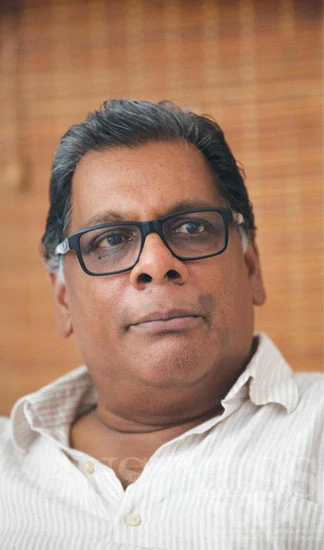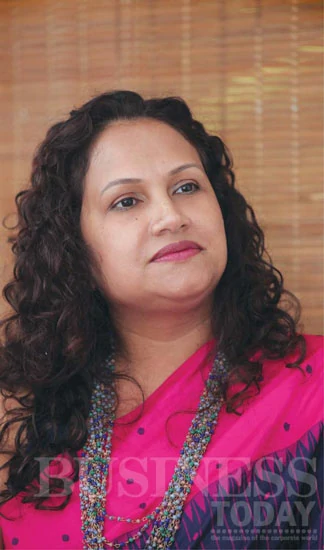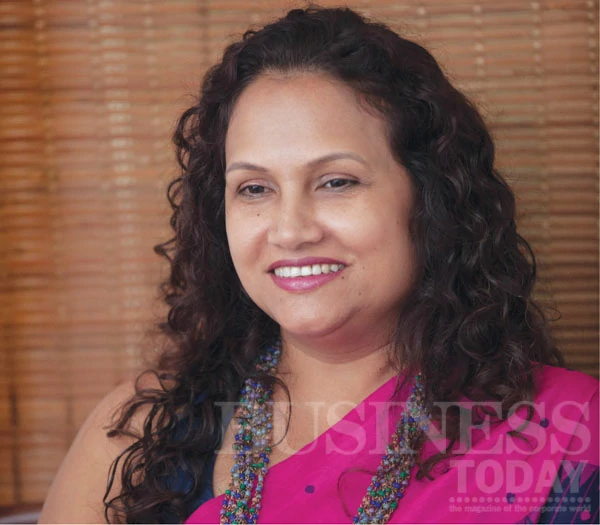
Bates Strategic Alliance has been the pioneer in Integrated Marketing Communications in Sri Lanka. Nimal Gunewardena, Chairman & CEO takes pride in having established a learning organisation that has introduced innovation and new thinking in the industry as well as being able to achieve equal representation of women professionals in the organisation. It gives him great pleasure to introduce his second in command Sheron Jayasundara, COO as she takes the reigns of the Four A’s as President this year. They stress that the advertising industry needs to get together and take those crucial steps forward to reunite and reignite the industry.
Photography Mahesh Bandara
What can you tell us about the advertising industry in Sri Lanka?
NG: Let me start with my own organisation, which I founded in 1993. I started the Agency that is now known as Bates with a certain vision, having been in the marketing and communications industry for a long time with my career spanning 40 years. Having started in advertising under an ad guru, and spending over ten years in marketing, and heading JWT for three years,I decided to create my own business. My vision for Bates was to be different to the ad agencies that had existed for many years by then, and drive a concept that was becoming popular at the time-integrated marketing communications. Public Relations, Direct Marketing, BTL and similar disciplines were gaining ascendancy globally. I felt that this was what our agency was going to be. We were the first to introduce PR to complement the ad agency business as the first step in developing an integrated communications agency.
Advertising had been there for many years and ad agencies already had a long tenure. PR was a new area, and we acted as evangelists for this discipline. We started talking to the media and told them that we could help with content for business stories, in the early days of business programmes and press. The business press was developing and business magazines also came into being in the ensuing years. Twenty two years later, we remain evangelists for PR, having embraced the broader scope of PR from advocacy to issues, crisis and change management and developed an experience curve in these, and continue to convince companies about managing their corporate reputation, which is what PR is all about.
Coming to the industry, by 1991 the advertising industry had fallen apart following the Ola Awards, the creative awards at the time, and for about eight years ad professionals were not working together as an industry, which was very unfortunate. Since this was unhealthy for the industry, we eventually started initiating informal meetings between agency heads in an ‘Agency Heads’ Forum’. In 1999, I took it upon myself to revamp the constitution of the Four A’s, the advertising industry body, removing the divisive clauses that kept agencies apart and including those that would bring people together. The Four A’s was literally reborn in 1999 and I was urged to take leadership as its President. We did many activities following its re-inception.
Twenty Two Years Later, We Remain Evangelists For PR, Having Embraced The Broader Scope Of PR From Advocacy To Issues, Crisis And Change Management And Developed An Experience Curve In These…
Education is one aspect we focused on because there was a huge need to develop skills and find and attract creative talent. As we came together, Agency leaders in the Committee took the responsibility and initiated new things. For example, Lilamani Dias Benson developed a preliminary course called “Adskool” and so on. Other activities and courses were introduced to attract people into the industry.
Ours is a very social industry. We all like a party, getting together and having a good time as we have many young people in this industry. This is another thing we focused on starting with a grand party to re-launch the Four A’s then. It is important to start doing social events to bring people together, to interact and meet each other more frequently. If not, we could all slide into our own silos and go on our own tracks seeking our individual fortunes and not think of the broader picture. The industry has to ensure that we build an industry that attracts talented people, where everyone has a place, and where there’s room and business for all.
This was the thinking, and the ad industry eventually started on its own creative awards again, ‘The Chillies’-which was held successfully for several years until 2008, when everything turned sour again. I remember that year well, because Bates won big with ‘Campaign of the Year’ and several other awards for Hutch and others. The next year when the time for planning the awards came, there were many disagreements and objections leading to legal issues as well, and as such no one wanted to take the risk to organise the awards. ‘The Chillies’ has not been held since. Some other activities have taken place in recent years among the Four A’s, the IAA and supporting organisations such as SLIM and Metal Factor. Seven years later, now in 2015 agencies are back again saying that something should be done to revive the awards and industry.
So today, Sheron has a big challenge of a similar nature to what I had then, as she takes the helm of the Four A’s at this time. She has been elected as its President and is seeking to get everyone together for the betterment of the industry. I have suggested a similar approach to start with the educational and social side to bring people together and eventually work towards the more daunting tasks.
Sheron Has Been Elected As The Four A’s President And Is Seeking To Get Everyone Together For The Betterment Of The Industry.
SJ: There is great interest where many in the industry want to come together in a stronger way, but the challenge is getting everyone together at a common forum. We have tried many times from last year to start a dialogue with the agency heads and get them to commit. Without their commitment, it is difficult to proceed further and conduct new initiatives, even an award ceremony like ‘The Chillies’.
We are actually missing having a creative awards scheme for the industry, because with that everyone strived to do better and better. Even the clients saw great ideas coming from the agencies, but today because of the lack of creative recognition of people and agencies, the Big Ideas just aren’t coming. That is why we are trying to re-introduce the awards, but it will be a very big challenge. Everyone feels the need, because that was the one forum that demonstrated our industry’s capability and also attracted new talent.
Today, the vibrancy that this industry enjoyed needs to be freshly rekindled. Bringing that back is the most important aspect. You can have forums and training sessions, but they are confined to the agencies themselves and perhaps a few agencies will come together during these programmes. But if you want to showcase the creative talent in the industry and our capability as creative agencies to everyone, then there has to be some recognition for that. This is successfully happening in the marketing sector. In the advertising industry we do not have a forum to demonstrate our creative flair other than the Effie awards which judges mostly effectiveness in communication.
We Have Many Ideas To Bring The Vibrancy Back To The Industry, Which We Will Work On Through The Four A’s..
We want to have more young people joining the industry. We are looking at tying up with the Press Institute to introduce a diploma course to attract people into advertising and PR and getting them to see the value of joining the industry. In this manner we have many ideas to bring the vibrancy back to the industry, which we will work on through the Four A’s.
In Sri Lanka we have a number of advertising agencies. Is our market big enough for such a large number of players?
NG: Yes, as the Sri Lankan economy grows, this should fuel related investments in brand building and marketing communications. Increased competition also generates competitive advertising expenditure. There will be enough space for everyone provided we all learn to act in fairness and in sharing the pie, rather than agencies seeking to build their own empires with aggressive competitive tactics. This has happened in the past, and unfortunately our industry competes in a huge ‘bloody’ red ocean. I cannot subscribe to the need to be the biggest, richest or mightiest agency, no one really needs to have such ambitions. I definitely do not want to be that. My intention is to be something entirely different. I would rather Bates be a pioneer, an innovator and a place where people learn and achieve, than anything else and that is what we have been.
At Bates we pride ourselves on being a learning organisation. I am personally at heart a teacher, being a former marketing lecturer. That is why I have made Bates a learning agency and many people have learned working with us whether it is PR, strategy or advertising, and appreciate that grounding they received even when moving to other careers. They remember the good experience and always keep in touch. We have a large and loyal alumni group. Not surprisingly, we also have a history of people who return to Bates after going on to seek other experiences because they feel they are a part of our family. That gives me greater satisfaction, than trying to be the king pin of all.
In recent years, we have ventured into digital, which is the future of advertising. There are a number of ‘blue ocean’ areas that we have identified for us to look at in the future. Marketers and the ad industry are still largely engaged in what we did in the last century-that is press, radio and television advertising. Technology has changed the world of communications, and the consumers’ media consumption patterns and habits have changed dramatically. Marketers and agencies need to understand these trends and how today’s consumer seeks information, spends time online, uses social media to share and influence, and get bold in experimenting in the new media realm to engage and collaborate with consumers. This to me is an exciting place we want to be in the future.
SJ: The number of agencies and how big they are do not matter. It is about understanding and responding to the changing needs of the consumer, and our clients are also being smarter in finding that niche, which they can operate and succeed in. It is no longer about ad agencies doing commercials only for television, radio and newspapers. It is that we need to identify the new trends and find new avenues to produce and execute our creative ideas in order to be able to sell our clients’ brands more effectively.
Today Effective Communication Is Becoming More And More Relevant. Being Creative Is One Thing But The Smaller Niche Agencies Have Come In And Found Market Opportunities…
Today effective communication is becoming more and more relevant. Being creative is one thing, but the smaller niche agencies have come in and found market opportunities, which sometimes the bigger agencies may not be able to address. In that sense it is good to have that varying competitiveness, so then you evolve with the times and are in touch with the trends and you look at the consumers more carefully. While it may be true that we do not have that many large brands like other overseas markets do, we also need those new agencies that have a fresh perspective.
50 percent of the professional staff at Bates are women, can you talk a little bit about this achievement?
NG: It is something that has happened automatically. We recruited the best candidates available and equal numbers happened to be women. So now we have gender equity in our professional cadre and in the management team as well. My personal assistant Nishi, who now heads HR, has been with us for the full 22 years, and Sheron has been at Bates for 18 years. Our Finance Head and many second level professionals are also women. In an industry noted for high turnover, we have many such people who joined, became passionate, dedicated and loyal to the organisation, made good and found a happy place here. We have been totally blind to demarcations such as gender, race or religion. So, we have a happy family of people reflecting a nice diversity in addition to the 50 percent of our professional staff who are women.
Women do have certain qualities, which makes them more successful than men in this industry. They have a natural nurturing quality, which makes them very good at looking after teams. I find that they are very reliable and happy to take responsibility, perhaps they do not feel the compulsion to seek their next career move. They will stay in an organisation if they are happy and find success, contentment and challenge, which is what we try to create with values of fairness, appreciation and personal development within a happy environment. We are very proud of our team and it has worked for us.
Work and clients can be demanding in this field, and women being very sociable thrive in our environment where interacting, persuading, and reassuring plays a key role, which makes them effective in managing client relationships-getting clients to listen, appreciate and collaborate. We have added women who are talented professionals with relevant academic backgrounds from the design schools and universities. We have found that women can make good writers, content creators, designers, art directors, and PR consultants and also succeed in management positions.
Sheron is a good example of our women in management. As the Agency’s Chief Operating Officer, Sheron oversees and manages the day-to-day operations of our business and our client relations as well.
SJ: I joined Bates in 1997 and I have grown with the organisation. I joined as an Account Manager and I guess Nimal saw the potential in me, so as time progressed I was offered and took on different responsibilities and challenges and today I am running the advertising operation as the COO of this flagship business unit. I feel that women are able to succeed in this field because they are able to multi-task. It calls on you so many times on a daily basis. Women are good at getting things done. From an agency point of view, what you need is loyalty and women have immense loyalty to their home, office and colleagues. They are also very trustworthy.
Women are not swayed by money or power to keep moving from place to place. They look for value in the work that they do as well as job satisfaction instead of going for monetary perks. Working for Nimal entailed in a greater freedom to fulfill our responsibilities and we were able to reach our full potential. We have a culture, which has been cultivated by him from the beginning and today we remain true to that culture. That is the family atmosphere where we help everyone and work as a team. Whether it is a client presentation or whether it is a sad moment, whatever it is, we will all be together and help each other.
Even in the industry Bates is known for that. When I was elected as the President of Four A’s many people pledged their support and said they would wholeheartedly rally around to help me and the Four A’s in its future endeavours. This is because of the trust we have created in the industry for our values of balance, fairness, integrity and giving of our efforts to better the industry, which is what I believe the industry needs at this time.
Many attended the AGM to support my candidacy. We have been able to take what we learnt here even outside the office. We have been straight and true to everyone including the industry. We have steered clear of organisational politics. That is something that Nimal has cultivated in us all and we have maintained this both within our agency and in the industry. Many people have pledged their support to me from the various agencies, so I am positive that we will be able to work together to uplift the industry. I will be the President of Four A’s only for one or two years, but if we do something for the industry it will benefit the next generation. We need to start somewhere and if we can make a fresh start at rallying everyone positively and committedly together that’s all that’s needed. It’s not about me or the Board, but rather about driving our industry forward and so it is up to all of us to work together and make things happen.
Many Ad Agencies Still Continue In The Same Red Ocean Of The Last Century—Mass Media Broadcast Advertising. There Are Many New Blue Oceans That Have Appeared In This Century, Which Are Driven By New Technology, And Changes In Consumer Behaviour.
Future plans?
NG: After 22 years of driving this mainstream business, I am at that stage where I am looking at new ‘start-up’ things to do, for fresh stimulation. I have been looking at trends in where brands, marketing and communications are going and looking for unfulfilled gaps that could present opportunities. Many ad agencies still continue in the same red ocean of the last century-mass media broadcast advertising. There are many new blue oceans that have appeared in this century, which are driven by new technology, and changes in consumer behaviour. I want to take our organisation in these new directions, for example with a strong push in the digital and social media realm. This will be the new conversation place, both for marketing communications and PR.
This whole scene is changing so rapidly that you need young people who are tech savvy, who are online and checking out new things to drive initiatives in this space. People, particularly in the youth market, are not tied to traditional mass media as the main source their information and entertainment, and are fast moving to tablets and smartphones even going beyond desktops and laptops, to get their information on the go.
Recently ICTA announced an initiative together with the industry to grow the online and broadband market by providing access to free Wi-Fi, with 1,000 hot spots this year and download access for all at train stations, universities and hospitals . While smartphones are growing rapidly, online access is the other essential for mass engagement. Sri Lankans are increasingly online and on Facebook, especially in the 18-34 age group, so these channels and realities cannot be ignored by marketers targeting youth markets.
Education and training for personal effectiveness is another area I’d like to explore. Marketing in the future will be driven both by people and technology. So working in the people side and imparting skills like problem solving, critical thinking, applying technical knowledge and idea generation could help deliver greater effectiveness in the marketing and service delivery task to be in line with what brands promise. This is also another untapped area.
The other pursuit I’d like to spend some time in is edutainment. In 2006, I developed a garden theatre production called ‘Brands, Blues and Change-points’ to engage with clients and marketers on issues of marketing and communications. We combined monologues with original songs and audience quizzes and discussions to engage the audience and get them to think. Since that was in the infancy of Facebook and digital engagement, I’d like to do a 2.0 version that will look into the reality of today’s digital world and also address issues on health worries and sustainability which are increasingly important ones for marketers to deal with in the future.








